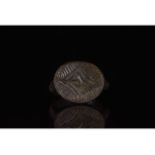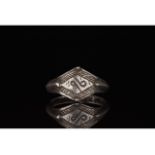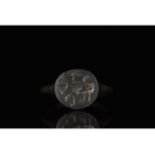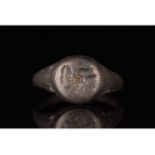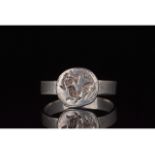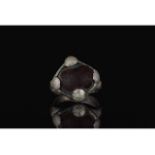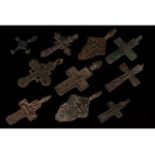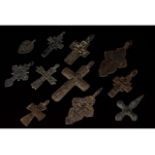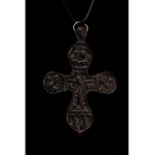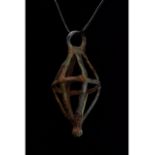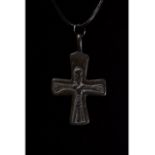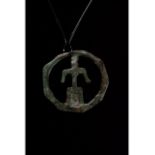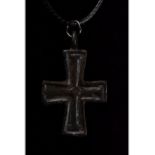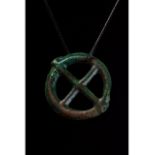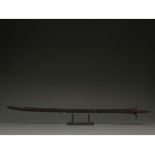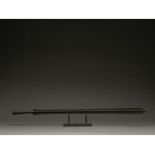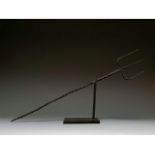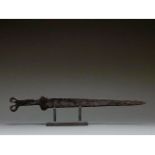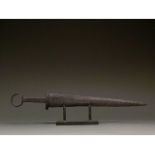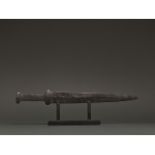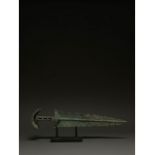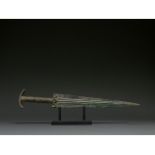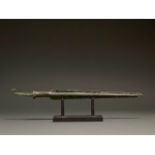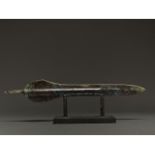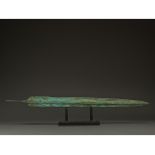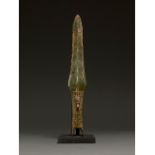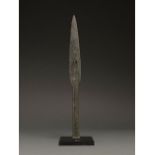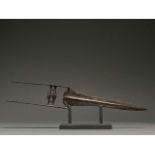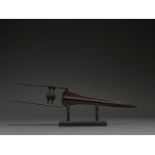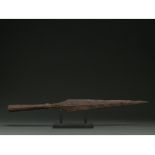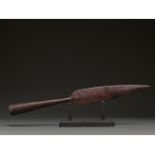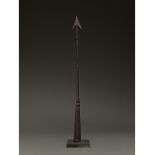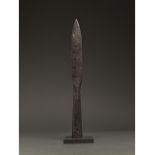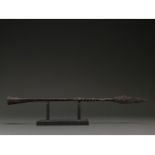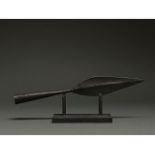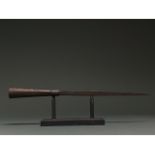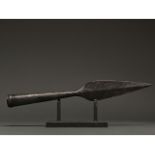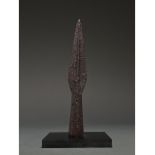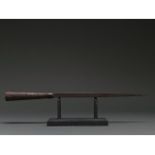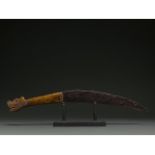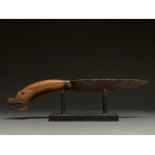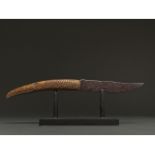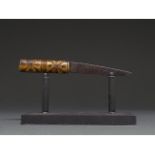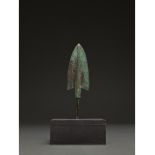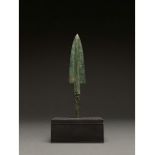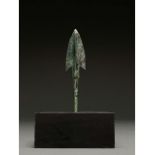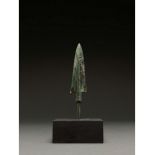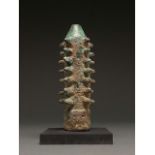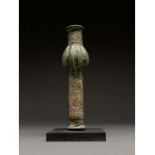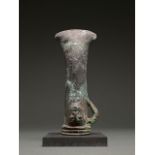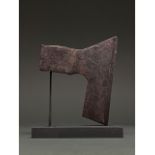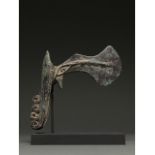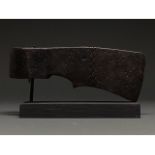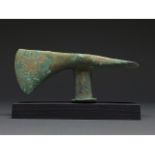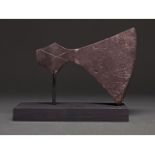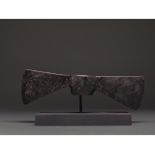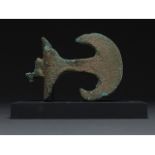Refine your search
Estimate
Category
- Arms, Armour & Militaria (123)
- Jewellery (90)
- Greek, Roman, Egyptian & Other Antiquities (39)
- Sculpture (20)
- Collectables (15)
- Scientific Instruments (14)
- Glassware (13)
- Salvage & Architectural Antiques (12)
- Metalware (10)
- Coins (9)
- Ceramics (4)
- Vintage Fashion (4)
- Musical Instruments & Memorabilia (3)
- Silver & Silver-plated items (2)
- Sporting Memorabilia & Equipment (2)
- Textiles (2)
- Books & Periodicals (1)
- Stamps (1)
- Tools (1)
- Wines & Spirits (1)
Filtered by:
- Item Type
- List
- Grid
A subscription to the Price Guide is required to view results for auctions ten days or older. Click here for more information
c. 1000-1500 AD, Crusader Period. Bronze ring with a thick circular hoop and a elliptical bezel featuring an incised Star of BethIehem motif. In t...
C. 1000-1500 AD. Medieval Period. This beautiful silver ring comprises a circular hoop and a lozenge-shaped bezel with incised linear and curvilin...
ROMAN BRONZE RING WITH CENTAUR
100-300 AD. Roman. Bronze ring with circular hoop and raised, round bezel featuring an engraved centaur holding a drawn bow. In Greek and Roman my...
700-1100 AD. Viking Age. Silver ring with circular hoop and round bezel bearing an engraved raven motif. Hugin or Munin. Hugin and Munin (pronounc...
ROMAN SILVER RING WITH CENTAUR
100-300 AD. Roman. Silver ring with circular hoop and applied round plate bezel featuring an engraved centaur. In Greek and Roman mythology, cent...
VIKING SILVER RING WITH STONE
700-1100 AD, Viking Age. Silver ring with a circular hoop, and a lozenge shaped bezel onto which is mounted a large, circular dark red gem. This s...
C. 1200 - 1800 AD. Medieval and post-Medieval. A beautiful collection of 10 cross pendants including bronze and iron examples, all of which are ca...
C. 1200 - 1800 AD. Medieval and post-Medieval. A beautiful collection of 10 cross pendants including bronze and iron examples, all of which are ca...
1000-1500 AD, Medieval Crusader period. A bronze pendant in the form of a Greek cross with rounded arms and a rounded suspension loop at the top. ...
BRONZE AGE CAGE PENDANT
C. 600 BC, Bronze Age. Large bronze cage pendant. The pendant's openwork biconical shape is formed of a combination straight and curved bars of br...
1000-1500 AD, Medieval Crusader period. A large bronze pendant in the form of a Latin cross with flaring arms and a rounded suspension loop at the...
900-1100 AD. Viking Age. A rare bronze zoomorphic amulet comprising a hexagonal frame surrounding a stylised figure of a person with hands held by...
1000-1500 AD, Medieval Crusader period. A bronze pendant in the form of a Greek cross with flaring arms and a rounded suspension loop at the top. ...
BRONZE AGE WHEEL PENDANT
Ca. 600 BC. Bronze Age. Bronze age wheel pendant comprising circular hoop and crossed spokes. In ancient societies, wheel amulets were traditional...
C. 600 AD. Migration Period. A long iron sword with a long, pointed, bevelled blade, a rectangular guard, and a long, rectangular tang for affixin...
c. 323-31 BC. Hellenistic. Huge iron spearhead with leaf-shaped blade, prominent midrib, flaring shoulder and circular socket. The Hellenistic per...
ROMAN IRON TRIDENT
100-300 AD. Roman. Iron trident with three long, widely-spaced prongs and twisted tang for insertion into a wooden haft. A trident is a three-pron...
600-400 BC. Scythian. Iron Acinaces-type sword with pointed, elongated triangular blade, B-shaped guard, rectangular handle and openwork winged po...
600-400 BC. Scythian. Iron Acinaces-type sword with pointed, elongated triangular blade, rectangular guard, tapering handle and ring pommel. The a...
600-400 BC. Scythian. Iron Acinaces-type sword with pointed, elongated triangular blade, narrow guard, rectangular handle and pommel. The acinaces...
1200-700 BC, Greek Archaic Period. This beautiful bronze sword has a tapering, bevelled blade with raised midrib, an integral handle with openwork...
1200-700 BC, Greek Archaic Period. This beautiful cast bronze sword has a tapering, bevelled blade with tripartite raised midrib with a double ful...
1200-700 BC, Greek Archaic Period. A beautiful cast bronze sword bronze sword with a leaf-shaped, lentoid sectioned blade,a tripartite raised midr...
1200-700 BC, Greek Archaic Period. This beautiful bronze spear has a tapering, bevelled blade with a prominent midrib, a neck with twisted decorat...
1200-700 BC, Greek Archaic Period. This beautiful bronze dagger has a leaf-shaped, bevelled blade with a prominent midrib, and a tang for insertio...
1200-700 BC, Greek Archaic Period. A This beautiful cast bronze sword with a leaf-shaped, lentoid sectioned blade, a tripartite raised midrib with...
c. 475 BC – 221 BC. Warring States Period. Bronze spearhead with leaf-shaped, lentoid-section blade and central midrib. The lower part of the sp...
c. 475 BC – 221 BC. Warring States Period. Bronze spear with pointed, triangular head, elongated shank, projecting hammer-head cross-guard and c...
800 – 600 BC. Greek Hoplite Period. Socketed Bronze spearhead comprising a substantial leaf-shaped, lentoid-section blade with a truncated raise...
C. 1526 - 1857 AD. Mughal Empire. An iron Katar dagger or knuckleduster comprising a two-part, bulging grip with guard and leaf-shaped blade with ...
C. 1600 – 1800 AD. Post-medieval. An iron Katar dagger or knuckleduster comprising a two-part, bulging grip with guard and leaf-shaped blade wit...
1400-1500 AD. Late medieval. Iron spearhead with elongated lozenge-shaped head, terminating in a narrow point, narrow cheek, flaring neck and circ...
C. 300-500 AD Roman. A large iron spearhead comprising a slender leaf-shaped, lentoid sectioned blade with a slightly raised midrib and a socket f...
C. 100-300 AD. Roman. An iron pilum spear head with a barbed, triangular blade, and a long, narrow neck, and a robust flaring socket. Pila were a ...
C. 300-500 AD Roman. An iron spearhead comprising a slender tapering blade and a long socket for increased control. Weapons of this type were used...
C. 1-300 AD. Roman. A large socketed iron pilum spear head with a leaf-shaped blade and twisted neck. Pila were a key part of Roman military equip...
c. 200 BC. Celtic Iron Age. Large iron spear comprising a pointed leaf-shaped blade with a prominent midrib and round, conical socket. Excellent c...
900-1100 AD. Viking Age. Iron lancehead with pointed, pyramidal head, flaring neck and circular socket. The era known as the Viking age lasted for...
900-1100 AD. Viking Age. Large iron lancehead with pointed, leaf-shaped blade with bevelling, flaring neck and circular socket. A raised rib with ...
C. 300-500 AD Roman. An iron spearhead comprising a squat leaf-shaped, lentoid sectioned blade with a raised midrib and a socket for increased con...
900-1100 AD. Viking Age. Iron lancehead with pointed, pyramidal head, flaring neck and circular socket. The era known as the Viking age lasted for...
C. 900 AD. Viking age. Medieval Scandinavian, pointed knife; expertly cleaned and conserved with hand-carved, reconstructed bone handle depicting ...
C. 900 AD. Viking age. Medieval Scandinavian, pointed knife; expertly cleaned and conserved with hand-carved, reconstructed bone handle depicting ...
C. 900 AD. Viking age. Medieval Scandinavian, pointed knife; expertly cleaned and conserved with hand-carved, reconstructed bone handle depicting ...
C. 900 AD. Viking age. Medieval Scandinavian, pointed iron knife; expertly cleaned and conserved with hand-carved, cylindrical bone handle. The fl...
ANCIENT BRONZE SPEAR ON STAND
1200-700 BC, Greek Archaic Period. Bronze Age. A bronze spearhead with a leaf-shaped, lentoid sectioned blade, a raised midrib and a short neck de...
ANCIENT BRONZE SPEAR ON STAND
1200-700 BC, Greek Archaic Period. Bronze Age. A bronze spearhead with a broad leaf-shaped, lentoid sectioned blade, a raised midrib and a short n...
ANCIENT BRONZE SPEAR ON STAND
1200-700 BC, Greek Archaic Period. Bronze Age. A bronze spearhead with a leaf-shaped, lentoid sectioned blade, a raised midrib and a short neck th...
ANCIENT BRONZE SPEAR ON STAND
1200-700 BC, Greek Archaic Period. Bronze Age. A bronze spearhead with a broad leaf-shaped, lentoid sectioned blade, a raised midrib and a short n...
ANCIENT BRONZE SPEAR ON STAND
1200-700 BC, Greek Archaic Period. Bronze Age. A bronze spearhead with a flaring leaf-shaped, lentoid sectioned blade, a raised midrib and a short...
C. 2000-700 BC, Luristan culture. A Luristan cast bronze mace head with a pointed tip, cylindrical body featuring four neat rows of spikes running...
ANCIENT BRONZE AGE MACE HEAD
C. 2000-700 BC, Luristan culture. A Luristan cast bronze macehead with cylindrical body which flares at both top and bottom. About one third from ...
2000-700 BC. Bronze Age. Rare axe head with short, crescentic blade, elongated cylindrical cheek, projecting loop handle and stepped socket. A mou...
900-1100 AD. Viking Age. Iron battle axe with heavy, elongated, straight blade, tapering cheek and reinforced rectangular poll. An incised star mo...
C. 2000-700 BC, Luristan culture. Zoomorphic bronze axe head with curved blade, raised midrib and stylised eye design. The butt of the axe feature...
900-1100 AD. Viking Age. Iron battle axe with short, slightly curved blade, elongated cheek with a small hook in underbelly and heavy, reinforced ...
1200-700 BC. Bronze Age. Beautiful bronze axe head with short, curved blade, triangular cheek, rounded socket and handle-sleeve and a spiked proje...
900-1100 AD. Viking Age. Iron battle axe with wide, fan-shaped blade, tapering cheek and rectangular poll. An incised cross motif is visible on th...
900-1100 AD. Viking Age. Double-bladed iron battle axe with a reinforced poll and socket; an elongated wedge-shaped cheek and short blade project ...
c. 2000-1000 BC, Amlash culture. Rare bronze axe with crescentic-shaped blade, narrow cheek, round socket, and elongated flanges; a cast animal pr...

